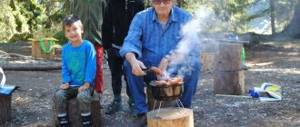One of the main tasks of parents is to teach children how to behave safely on the street in the absence of adults. Rules of behavior on the street for children can help with this. Since modern life is unpredictable and dangerous, it is important from an early age to develop in your child attentiveness and the ability to act correctly in an unusual situation.
According to statistics, children who always and everywhere go with their parents subsequently have poor orientation and adaptation and are unable to ensure their own safety, since they have always trusted their relatives. However, this does not mean that a child who does not yet understand what danger is should be left unattended. Safety rules and growing up must be learned gradually. Parents are not recommended to go to extremes and not let their child leave them until adolescence.
Where is the best place to start?
For training to be effective, it is not enough to simply talk about safety rules. Of no small importance is the choice of the correct form and methods that correspond to the age and level of development of the child. We suggest you familiarize yourself with some of them, depending on the age of the children:
- For children aged 4 to 6 years, the rules of safe behavior will be better learned in a playful way using toys and other improvised objects. For example, you can stage a situation on the topic “Actions if your favorite toy is lost.”
- With 7-year-old children, it is useful to create a script based on a fictional scene. This will push the child to find the right way out of difficult situations.
- It is better to discuss with teenagers what is allowed and what is not. For example, you should delineate places where a child should not go without adults. In adolescence, a child needs to know emergency numbers and options for whom and where he can turn in difficult situations.
It is not recommended to focus on bad events and sad statistics, as this can intimidate the child. As a result, he will not learn anything except fear and uncertainty. It is better to focus on the safe behavior of children on the street, to encourage the desire to share their own problems with an adult, to be on the same emotional wavelength with him.
The parents’ own example is also important. After all, if you tell a child, for example, that the road must be crossed strictly when it is green, and regularly break this rule yourself, you may not expect compliance with the rule in the future.
When talking about the safety of children on the street, one should not miss the fact that some factors and aspects of his behavior can provoke dangerous situations.
Carefully! Road! (conversation on traffic rules)
Conversation
"Carefully! Road!"
Tasks:
- Consolidation of knowledge on traffic rules and safety on roads and in transport;
- Fostering a culture of behavior on the road and in transport, in order to prevent child road traffic injuries.
Progress of the event:
1. Introduction (introductory speech by the class teacher). Compliance with traffic rules is the law of preserving life. One cannot but agree with this. However, statistics say: approximately three quarters of all road accidents involve children. Let's think about what these reasons might be. The most common are: -Crossing the roadway outside the designated crossing areas. -Unexpected exit due to moving or stationary vehicles or other obstructions that obstruct the view. -Disobeying traffic lights. -Games on the roadway and walking along it if there is a sidewalk. How can you protect yourself from rash actions on the road? How to prevent an increase in road accidents involving schoolchildren? To do this, it is necessary to attach great importance to the topic of security. And we'll talk about this today.
2. Main part (Conversation with the class).
Imagine that all the traffic lights in our city suddenly went out. And all the inspectors regulating traffic have disappeared somewhere. What consequences might there be? (Discussion of the issue). Every day more and more cars appear on our roads. High speeds and traffic volumes require drivers and pedestrians to be very careful. Discipline, caution and compliance with traffic rules by drivers and pedestrians are the basis for safe movement on the street. What is a traffic accident? (Discussion of the issue by students). Of the total number of road traffic accidents, half involve pedestrians. This is a terrible indicator, indicating the low culture of both pedestrians and drivers. It turns out that pedestrians do not have the patience to wait for the right moment to cross the road. Half are willing to stand on the sidewalk for just 4 seconds, while the fifth are willing to risk their lives to end up on the opposite side of the road. We must fight such impatience, remembering that the one who “hurries slowly” comes first. A striped path (“zebra”) only to some extent guarantees your safety on the road. Scientists have found that seven out of ten drivers who are busy talking on a cell phone will not give way to pedestrians at a zebra crossing. Today we will try to figure out what we are doing wrong on the road. Let's start with the most common vehicle available to schoolchildren - a bicycle. Let's remember the first thing: this is the most unprotected vehicle. It does not have doors that protect against side impacts, and there is no bumper that would partially absorb a frontal impact. Therefore, in any collision or collision with an obstacle, the cyclist is very vulnerable. Second: it is comfortable to ride a bicycle where a special safe zone has been created for this. Third rule: never try to pass between a moving and a stationary car. Stop and let the car coming towards you pass. Don't take this as cowardice, it's just common sense. Now the main thing: try not to drive onto the roadway, even if you are over 14 years old. You can ride a moped on the roadway from the age of 16. But remember: you should only move in the far right lane, in one row, as far to the right as possible. The relative safety zone ends further than one meter from the sidewalk.
3. Consolidation of what has been learned (in a playful way).
3.1.Answers to questions:
-The roadway is paved. (Highway). -A person traveling in a vehicle. (Passenger). -A person moving on foot. (A pedestrian).
-It can be prohibitive, permissive, or informational. (Sign)
-The strictest road signs. (Prohibiting).
-Who should know road signs? -Waiting place for the bus. (Stop). -Vehicles powered by electricity. (Trolleybus, tram). -Emergency telephone number. (03). -A place where you leave your transport for a while. (Parking). -Multi-seater vehicle for transporting passengers. (Bus). -Path along the road, not for cars. (Sidewalk). -This happens to those who do not follow traffic rules. (road accident). -The most dangerous place for pedestrians. (Crossroads). -Rule breakers are afraid of him. (Inspector). -How is a pedestrian crossing marked on the carriageway of streets and roads?
-Pedestrian crossing is different. (Zebra). -In what places are pedestrians allowed to cross the street? -What rules of behavior in public transport do you know? -What is the procedure for boarding and exiting the bus? (they walk around the bus from behind)
-How should you cross the street or road correctly? -Is it possible to run across the street or road? -Why are pedestrians not allowed to walk along the roadway? -How many signals does a pedestrian traffic light have? -Which direction should you look when you reach the middle of the street? -Stowaway? -Road for a tram? -House for a car?
-Three-eyed guard. (Traffic light).
-What pedestrian traffic lights do you know, what do they mean?
-This is the yellow traffic light “saying”. (Attention).
3.2.Game.
And now we will play a little, and at the same time we will consolidate the theory. I offer you a game for your attention. I will show traffic lights. If red means you stand still, yellow means you clap your hands, green means you go to the other side of the class. So, pay attention!
3.3.Riddles: It will oblige us to drive quietly, A close turn will show And remind you of what and how you are on your way... (Road sign).
What is this zebra crossing on the road? Everyone stands with their mouths open. They are waiting for the green light to blink, so this means... (Transition).
A three-eyed scarecrow on one leg stood from the edge of the street in a long boot. Where cars move, Where paths converge, Helps people cross the road. (Traffic light).
Drinks gasoline like milk, can run far. She carries cargo and people. You are familiar with her, of course. He wears shoes made of rubber, called... (Machine).
3.4. "Inverted Words"
Here are words in which the letters are reversed. Try to restore them to their normal order (written on the back of the board).
For example, MAIZ - WINTER
SHYAMNA –
REVOSTOF –
KHOREDEP –
NIPSKERTO –
3.5. "Find the odd one out"
Look carefully at the rows of words. Three of them are related to each other in some way, and the fourth is different. Find the extra word (orally together):
a) Bicycle, bus, motorcycle, tram.
b) “Zhiguli”, “Zaporozhets”, “Volga”, “KAMAZ”.
c) Red, blue, green, yellow.
d) Traffic rules, traffic police, traffic police, housing and communal services.
3.6. "Unravel the phrases."
Guess what phrases are hidden under the numbers:
A-1, B-2, V-3, G-4, D-5, E-6, Zh-7, I-8, J-9, L-10, N-11, O-12, P- 13, R-14, S-15, T-16, U-17, Sh-18, L-19, Yu-20, Ya-21.
16, 8,18,6 6,5,6,18,19 – 5,1,10,19,18,6 2,17,5,6,18,19.
(The quieter you go, the further you'll get).
15,12,2,10,20,5,1,9,16,6 13,14,1,3,8,10,1 5,12,14,12,7,11,12,4,12 5,3,8,7,6,11,8,21!
(Follow traffic rules!).
4. Conclusion: today we learned how to behave while driving a bicycle. We remembered the main rules for driving this vehicle on the roads and in the courtyards of our city; remembered and reinforced the basic rules of the road. We understood the main thing - you shouldn’t expose your life to unjustified risk. Following traffic rules and being careful on the road is not cowardice, but smart calculation.
Rules of behavior on the street
Safe behavior is understood differently in each family, which is why parents draw up rules specifically for their children. We invite you to familiarize yourself with the basic rules of safe behavior on the street, which can become the basis for creating your own:
- You should always tell your parents where you are going, with whom and when you will return.
- There is no need to walk alone on the street at night. If it turns out that it is already dark, then it is better to get home through illuminated places.
- Do not attract unnecessary attention by talking loudly on the phone, etc.
- Do not wear expensive jewelry on the street, especially when walking without adults.
- There is no need to hang your house keys around your neck or on your trouser belt.
- If you find a young and noisy company, it is better to move to another street and under no circumstances enter into conflict with them.
- Avoid arguing in public places.
- If one of the passers-by asks for directions, you can explain and even draw the path, but do not accompany him to this place yourself.
- If a stranger asks you to help him with his bags, promising a reward for this, you must answer with a categorical refusal.
- If a stranger suggests that you try yourself in the field of show business and beauty, you should not hesitate to ask when and where you can approach this issue with your parents.
- If a car starts to slow down nearby, you need to move away from it and under no circumstances get into the car.
- If it seems like someone is following you, you need to cross the street, go into a store, or ask an adult for help, that is, draw attention to yourself.
- During games, you should not climb into abandoned vehicles, buildings or other similar places.
- If danger threatens, do not be shy to loudly call for help and defend yourself.
- In public places, public order, traffic rules and the use of vehicles must be strictly observed.
- Do not damage public and state property.
- Do not litter on the street and in public places.
- It is prohibited to drink alcoholic beverages or play cards.
- Treat nature and the work of other people with care.
Points regarding communication with strangers can be combined with a simple and understandable rule: “An adult will never ask a child for help.”
All points can be adjusted and supplemented depending on what the parents want to teach the child.
Tags:Street
We also recommend reading on this topic:
- Basic rules of behavior on the water for children: safety reminder
- Ice safety for children
- Basic actions and fire safety rules for children
- Safety rules for children in winter









